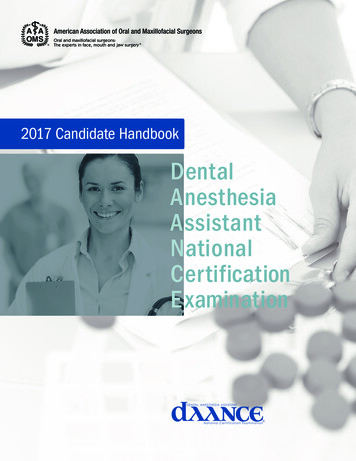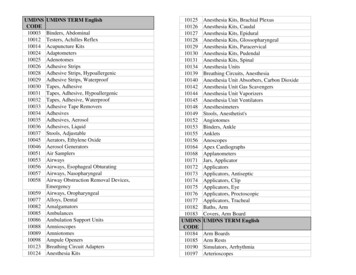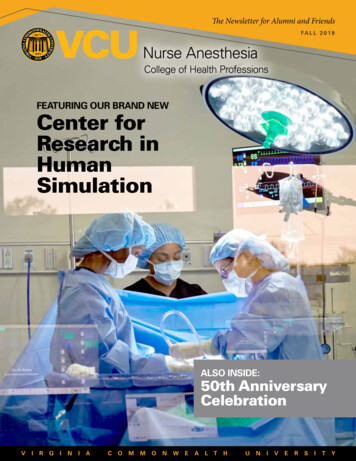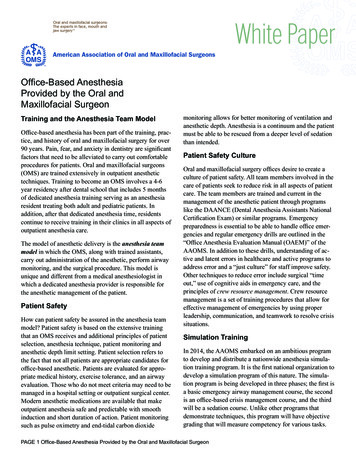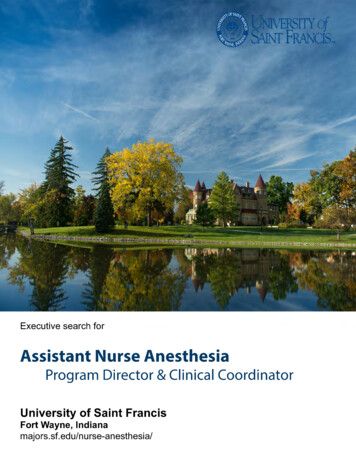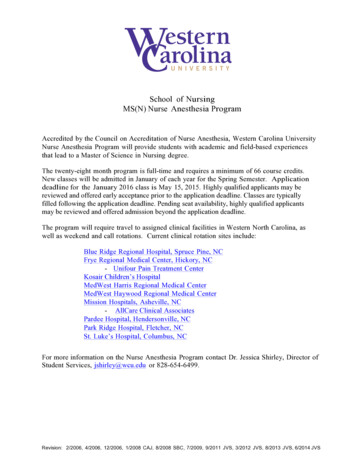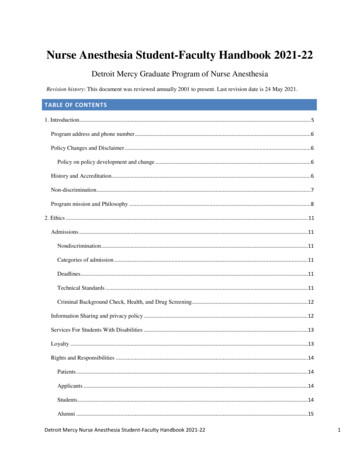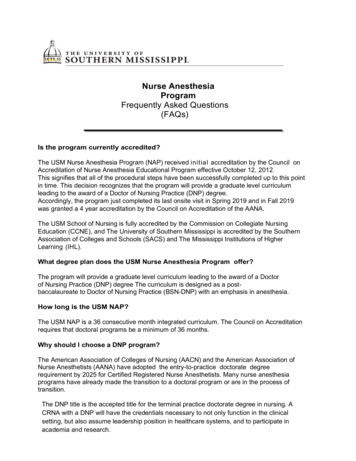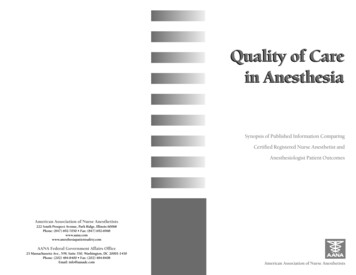
Transcription
Quality of Carein AnesthesiaSynopsis of Published Information ComparingCertified Registered Nurse Anesthetist andAnesthesiologist Patient OutcomesAmerican Association of Nurse Anesthetists222 South Prospect Avenue, Park Ridge, Illinois 60068Phone: (847) 692-7050 Fax: (847) mAANA Federal Government Affairs Office25 Massachusetts Ave., NW, Suite 550, Washington, DC 20001-1450Phone: (202) 484-8400 Fax: (202) 484-8408Email: info@aanadc.comAmerican Association of Nurse Anesthetists
Quality of Carein AnesthesiaSynopsis of Published Information ComparingCertified Registered Nurse Anesthetist andAnesthesiologist Patient OutcomesAmerican Association of Nurse Anesthetists222 South Prospect Avenue, Park Ridge, Illinois 60068Phone: (847) 692-7050 Fax: (847) 692-6968www.aana.com www.anesthesiapatientsafety.comAANA Federal Government Affairs Office25 Massachusetts Ave., NW, Suite 550, Washington, DC 20001-1450Phone: (202) 484-8400 Fax: (202) 484-8408Email: info@aanadc.comA special thanks to AANA Insurance Servicesfor its support in the production of this document.Copyright 2009 American Association of Nurse Anesthetists.
Table of ContentsINTRODUCTION . . . . . . . . . . . . . . . . . . . . . . . . . . . . . . . . . . . . . . 1SECTION ONESummary of Pertinent Quality of Care Studies and Data . . . . . . . .31. Needleman/Minnick OB Study in Health Services Research . . 32. Simonson OB Study in Nursing Research . . . . . . . . . . . . . . . . 53. Pine Study in the AANA Journal . . . . . . . . . . . . . . . . . . . . . . 74. Bechtoldt Study . . . . . . . . . . . . . . . . . . . . . . . . . . . . . . . . . . 105. Forrest Study . . . . . . . . . . . . . . . . . . . . . . . . . . . . . . . . . . . 116. Minnesota Department of Health Study . . . . . . . . . . . . . . . 137. Centers for Disease Control . . . . . . . . . . . . . . . . . . . . . . . . . 138. National Academy of Sciences Study . . . . . . . . . . . . . . . . . 149. Nurse Anesthetist Professional Liability Premiums . . . . . . . 14SECTION TWOAnesthesiologist Distortions Concerning Quality of Care . . . . . .151. Abenstein and Warner Article in Anesthesia & Analgesia . . . 152. Silber Study in Medical Care . . . . . . . . . . . . . . . . . . . . . . . . 203. New England Journal of Medicine Articles(by Wiklund and Rosenbaum) . . . . . . . . . . . . . . . . . . . . . . 224. Silber Study in Anesthesiology . . . . . . . . . . . . . . . . . . . . . . . 255. Vila Study in Archives of Surgery . . . . . . . . . . . . . . . . . . . . . .32SUMMARY . . . . . . . . . . . . . . . . . . . . . . . . . . . . . . . . . . . . . . . . . . 36BIBLIOGRAPHYSelected References on the Quality of Anesthesia Care byAnesthesiologists and Nurse Anesthetists . . . . . . . . . . . . . . . . . . 37APPENDIXNurse Anesthetist Professional Liability Premiums — PremiumChanges from 1988 to 2004 . . . . . . . . . . . . . . . . . . . . . . . . . . . . 38Quality of Care in Anesthesia
IntroductionNurse anesthetists have been providing quality anesthesia care in theUnited States for nearly 150 years. In administering more than 30 million anesthetics annually, CRNAs have compiled an enviable safetyrecord. No studies to date that have addressed anesthesia care outcomes have found that there is a significant difference in patient outcomes based on whether the anesthesia provider is a CRNA or ananesthesiologist.The practice of anesthesia has become safer in recent years due toimprovements in pharmacological agents and the introduction ofsophisticated technology. Recent studies have shown a dramaticreduction in anesthesia mortality rate to approximately one per250,000 anesthetics.The fact that there is no significant difference regarding the quality ofcare rendered by anesthesiologists and CRNAs is not surprising. “[A]nunderstanding of the nature of anesthesia would lead one to expectthis. The vast majority of anesthesia-related accidents have nothing todo with the level of education of the provider.” [Blumenreich, GA,Wolf, BL. “Restrictions on CRNAs imposed by physician-controlled insurance companies.” AANA Journal. 1986;54:6:538-539, at page 539.]The most common anesthesia accidents are lack of oxygen suppliedto the patient (hypoxia), intubation into the esophagus rather than thetrachea, and disconnection of oxygen supply to the patient. All of theseaccidents result from lack of attention to monitoring the patient, notlack of education. In fact, the Harvard Medical School standards inanesthesia are directed toward monitoring, which reiterates the basicpoint — most anesthesia incidents relate to lack of attention to monitoring the patient, not lack of education.As Blumenreich has stated:Anesthesia seems to be an area where, beyond a certain level,outcome is only minimally affected by medical knowledge but isgreatly affected by factors such as attention, concentration, organization and the ability to function as part of a team; factorstowards which all professions strive but which no professionmay claim a monopoly. See id. at page 539.Quality of Care in Anesthesia1
Section OneSummary of Pertinent Quality of Care Studies and Data1. Needleman/Minnick OB Anesthesia Study in Health ServicesResearch[Needleman, J, Minnick, AF. “Anesthesia Provider Model, HospitalResources, and Maternal Outcomes.” Health Services Research.November 2008. DOI: 10.1111/j.1475-6773.2008.00919x.]In the November 2008 online issue of Health Services Research, researchers Jack Needleman, PhD, MS, and Ann F. Minnick, PhD, RN,FAAN, published the results of a national study titled “AnesthesiaProvider Model, Hospital Resources, and Maternal Outcomes.” Usinga geographically broad sample of hospitals in seven states, Needleman/Minnick sought to determine the ability of anesthesia providermodels and hospital resources to explain maternal outcome variations. According to the researchers, “Given that almost 4 million U.S.women give birth annually, determining improvement strategies is important (National Center for Health Statistics 2005).” [page 3]The results of the Needleman/Minnick study revealed thatobstetrical (OB) anesthesia is equally safe in hospitals that useonly Certified Registered Nurse Anesthetists (CRNAs) or a combination of CRNAs and physician anesthesiologists, comparedwith hospitals that use only anesthesiologists. These results confirmed the results of a 2007 study using Washington state datathat revealed no difference in OB anesthesia complication ormortality rates between hospitals that use only CRNAs compared with hospitals that use only anesthesiologists (Simonson,et al.; see pp. 5-7 in this booklet.).A. Rationale for Undertaking StudyAccording to the researchers, high cesarean delivery rates and extensive use of epidural pain relief make anesthesia an important component of obstetrical care. This study was undertaken: To identify any systematic differences in outcomes between hospitals using CRNA-only, anesthesiologist-only, and CRNA/anesthesiologist staffing models. To determine the ability of anesthesia provider models and hospital resources to explain maternal outcome variations.B. BackgroundThe study involved more than 1.14 million OB patients from 369 hospitals in seven states, including California, Florida, Kentucky, New York,Quality of Care in Anesthesia3
Texas, Washington, and Wisconsin. Participating hospitals met the following conditions: reported at least one live birth in the 2002 AmericanHospital Association Annual Survey, provided at least one year of discharge data to state agencies, and responded to a 2004 survey on organization and resources of obstetrical services. Approximately 10percent of all births in U.S. hospitals from 1999-2001 occurred in thesefacilities.Data was assembled from the information given by the hospitals totheir state agencies and from the 2004 survey on obstetric services.Four outcomes were coded from the discharge data: death, anesthesia complications, nonanesthesia maternal complications, and obstetrical trauma. Hospitals were classified into one of five anesthesiamodels: anesthesiologist-only; CRNA-only; both anesthesiologists andCRNAs practicing at the hospital, with an anesthesiologist required tobe present at the initiation of all planned cesarean sections; both anesthesiologists and CRNAs practicing at the hospital, with an anesthesiologist not required to be present at the initiation of all planned cesarean sections; and hospitals in which the anesthesia model differedbetween labor/delivery and general operating areas.C. ConclusionsNeedleman/Minnick concluded the following: Hospitals that use only CRNAs, or a combination of CRNAs andanesthesiologists, do not have systematically poorer maternaloutcomes compared with hospitals using anesthesiologist-onlymodels. At least in the area of obstetrical services, there may be no gainin anesthesia safety from restricting which licensed providers canprovide anesthesia services. The use of CRNAs may make itpossible to provide obstetric anesthesia coverage where anesthesiologists are not available because of cost or other factorspertaining to regulation and payment.2. Simonson OB Anesthesia Study in Nursing ResearchVariables such as the organization of OB services and OB anesthesia,patient characteristics, and hospital characteristics were taken intoconsideration.[Simonson, DC, Ahern, MM, Hendryx, MS. “Anesthesia Staffing andAnesthetic Complications During Cesarean Delivery.” NursingResearch. 2007; 56:9-17]The researchers conducted a logistic regression of each outcomemeasure on a full model that included the anesthesia model, otherhospital characteristics, and patient characteristics. In addition, because anesthesia and other complications were more prevalent in patients undergoing cesarean deliveries, a logistic regression was alsoconducted on a full model for each outcome measure restricted to cesarean patients.In the January/February 2007 issue of Nursing Research, a team ofresearchers led by Daniel Simonson, CRNA, MHPA, published the results of a retrospective analysis titled “Anesthesia Staffing and Anesthetic Complications During Cesarean Delivery.” Using data from thestate of Washington, the researchers set out to identify differences inthe rates of anesthetic complications for cesarean section in hospitalswhere the obstetrical (OB) anesthesia was provided solely by CRNAscompared with hospitals where the OB anesthesia was provided solely by anesthesiologists.Significant Findings and Patterns. Several important findings andpatterns emerged from the Needleman/Minnick study: The death rate was very low (0.007 percent), and anesthesiacomplications occurred in less than 1 percent of the sample. The most common anesthesia model was anesthesiologist-only(39 percent); the second-most common was CRNA-only (23 percent). Death rates were highest in hospitals with anesthesiologist-onlymodels, although the differences were not statistically significant. Anesthesia complication rates were lower in the CRNA-only hospitals (0.23 percent) than in the anesthesiologist-only hospitals(0.27 percent). Rates in the other hospitals varied from 0.24 per4cent to 0.37 percent, with the differences not being statisticallysignificant from the anesthesiologist-only hospitals. Multivariate analysis found no systematic differences betweenhospitals with anesthesiologist-only models and hospitals withmodels using CRNAs. There was no consistent pattern associating other hospital or patient characteristics with outcomes.American Association of Nurse AnesthetistsThe study results showed that there is no difference in complication rates or mortality rates between hospitals that use onlyCRNAs compared with hospitals that use only anesthesiologists.A. Rationale for Undertaking StudyAccording to the researchers, the study was undertaken: To determine whether there are any differences between hospitals that employ only CRNAs to perform OB anesthesia andhospitals that employ only anesthesiologists to perform OBanesthesia. Because research data is needed to assist hospitals and anesQuality of Care in Anesthesia5
thesia groups in making cost-effective staffing choices.B. BackgroundFor purposes of the study, Washington state hospital admission datafor 1993-2004 were obtained from the Comprehensive Abstract andReporting System database and merged with data from a survey ofanesthesia or medical staff at hospitals where OB anesthesia wasstaffed by CRNAs only and hospitals where OB anesthesia wasstaffed by anesthesiologists only. A total of 134,806 patient recordswere analyzed, including those of 33,236 patients who were caredfor by CRNAs only and 101,570 who were cared for by anesthesiologists only.Regression analysis was used to adjust for independent variablessuch as hospital characteristics (geographic location, size, and teaching status), patient demographics (age, primary payer, and type of admission), and patient comorbidities.In the study sample, there were 965 OB anesthesia complications and17 deaths. According to the researchers, 76 percent of the complications were of a less serious nature per the International Classificationof Diseases, Ninth Revision, Clinical Modification (ICD-9-CM), andonly one of the deaths had an ICD-9-CM code associated with ananesthetic complication. The CRNA-only hospitals had a complicationrate of 0.58 percent, while the anesthesiologist-only hospitals had arate of 0.76 percent.Significant Findings and Patterns. Several important findings andpatterns emerged from the Simonson study: Hospitals with CRNA-only staffing had a lower rate of anestheticcomplications than those with anesthesiologist-only staffing (0.58percent vs. 0.76 percent, p .0006). However, after regressionanalysis, this difference was not significant. The CRNA-only hospitals had a greater percentage of Medicaid,rural, teaching, urgent admission, and very young (under 17years old) patients; the anesthesiologist-only hospitals had agreater percentage of emergency admissions and older mothers (over 35 years old). A substantially higher percentage of sicker patients were transferred to CRNA-only hospitals, a factor which could, potentially,affect the number of anesthetic complications in a facility. However, this did not prove to be the case.C. ConclusionsSimonson et al. concluded the following: That OB anesthesia complications are no different between the6American Association of Nurse AnesthetistsCRNA-only and anesthesiologist-only staffing models. “As a result, hospitals and anesthesiology groups may safely examineother variables, such as provider availability and costs, whenstaffing for obstetrical anesthesia.” [page 1] That further study is needed to validate the use of ICD-9-CMcodes for anesthesia complications as an indicator of quality.3. Pine Study in the AANA Journal[Pine, M, Holt, KD, Lou, YB. “Surgical Mortality and Type ofAnesthesia Provider.” AANA Journal. 2003; 71:109-116.]In the April 2003 AANA Journal, Dr. Michael Pine, a board-certifiedcardiologist widely recognized for his expertise in analyzing clinicaldata to evaluate healthcare outcomes, and a team of researcherspublished the results of a groundbreaking study titled “SurgicalMortality and Type of Anesthesia Provider.” The study analyzed theeffect of different types of anesthesia providers — specifically CertifiedRegistered Nurse Anesthetists (CRNAs) and physician anesthesiologists — on the death rates of Medicare patients undergoing surgery.The results revealed that patients are just as safe receivingtheir anesthesia care from CRNAs or anesthesiologists workingindividually, or from CRNAs and anesthesiologists workingtogether.A. Rationale for Undertaking StudyAccording to the researchers, the study was undertaken: To attempt to answer lingering questions about surgical patients’safety related to types of anesthesia providers, even thoughestimates of anesthesia-related deaths today are as low as 1in 200,000 to 300,000 cases. [To Err is Human: Building aSafer Health System. Kohn, LT, Corrigan, JM, Donaldson, MS.Washington, DC: National Academy Press. 1999.] To provide state governors with valid scientific data to help themdecide whether their respective states should opt out of the federal physician supervision requirement for nurse anesthetists.[Federal Register. Vol. 66, No. 219, pp. 56762-56769.] Withoutsuch data, governors must rely on older studies (see analyses ofBechtoldt and Forrest studies, pp. 10-13 in this booklet) or seriously flawed studies (see analysis of Silber/Pennsylvania study,pp. 25-32 in this booklet).B. BackgroundThe researchers studied 404,194 Medicare cases that took place from1995-1997 in 22 states. Only cases with clear documentation of type ofQuality of Care in Anesthesia7
anesthesia provider were studied, and adjustments were made fordifferences in case mix, clinical risk factors, hospital characteristics,and geographic location. The types of surgical procedures includedcarotid endarterectomies, cholecystectomies, herniorrhaphies,mastectomies, hysterectomies, laminectomies, prostatectomies, andknee replacements.Groundbreaking Results. The Pine study yielded the followingimportant findings: Mortality rates were similar for CRNAs and anesthesiologistsworking individually. There was no statistically significant difference in the mortalityrate for CRNAs and anesthesiologists working together versusCRNAs or anesthesiologists working individually. There was no statistically significant difference in the mortalityrate for hospitals without anesthesiologists versus hospitalswhere anesthesiologists provided or directed anesthesia care.C. ConclusionsPine et al. concluded the following: That while their findings differed from those of Silber et al. (seeanalysis of Silber/Pennsylvania study, pp. 25-32 in this booklet),they were consistent with earlier research and with current datawhich estimate that anesthesia-related deaths today are as lowas 1 in 200,000 to 300,000 cases. [To Err is Human: Building aSafer Health System. Kohn, LT, Corrigan, JM, Donaldson, MS.Washington, DC: National Academy Press. 1999.] That based on the surgical procedures included in the study,inpatient surgical mortality is not affected by whether theanesthesia provider is a CRNA or an anesthesiologist.Pine Versus Silber. The Silber/Pennsylvania study (see analysis onpp. 25-32 in this booklet), which was published nearly three yearsbefore the Pine study, contained glaring methodological deficienciesthat Pine et al. endeavored to avoid. Specifically, approximately twothirds of the cases which Silber et al. classified as not involving ananesthesiologist in the patient care either A) actually did have ananesthesiologist involved in some, but not all, of a patient’s procedures, or B) had no bill for the anesthesia care (making it impossible toconfirm whether an anesthesiologist was or was not involved).Further, cases in which anesthesiologists worked alone were notdistinguished from those in which CRNAs and anesthesiologistsworked together. Finally, only cases in one state — Pennsylvania —were included in the Silber study.8American Association of Nurse AnesthetistsThis failure by Silber et al. to more accurately quantify the cases inwhich anesthesiologists were involved led the researchers to concludethat there was an increase of 2.5 deaths per 1,000 patients when ananesthesiologist was not involved in the case. This inflated ratio wasalarmingly out of sync with the Institute of Medicine’s (IOM’s) publishedreport that anesthesia mortality rates today are approximately 1 deathper 200,000 to 300,000 anesthetics administered, a ratio also routinely cited by the American Society of Anesthesiologists (ASA). [To Err isHuman: Building a Safer Health System. Kohn, LT, Corrigan, JM,Donaldson, MS. Washington, DC: National Academy Press. 1999.]Had Silber et al. identified a more accurate (i.e., larger) number ofcases as involving anesthesi
American Association of Nurse Anesthetists Synopsis of Published Information Comparing . A special thanks to AANA Insurance Services for its support in the production of this document. . Needleman/Minnick OB S
